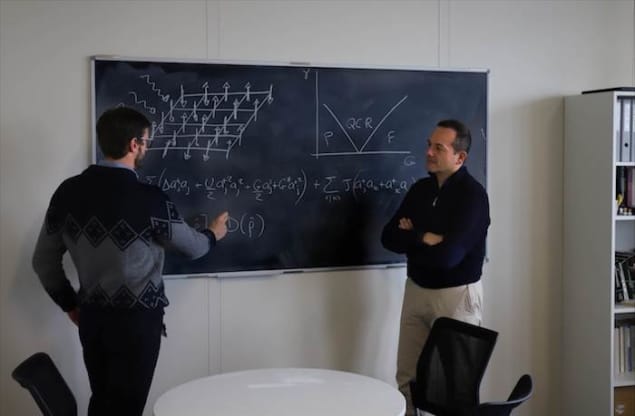
Photons can behave like magnetic dipoles at absolute zero temperatures. This is the new result from a quantum simulator put forward by physicists at the EPFL in Switzerland and Paris Diderot University in France. The theoretical study proves that simple photonics devices can be used to mimic the behaviour of complex materials under extreme conditions – experiments that are difficult to actually do in the laboratory.
Condensed matter systems, such as magnetic materials, containing many interacting particles show complex behaviour that is challenging to model even using the most sophisticated computer programmes. This behaviour can be modelled, however, using an artificial structure (or quantum simulator) subject to same laws of quantum mechanics – a concept first put forward by Richard Feynman in 1981.
Same behaviour as that in the Ising model
When magnets are cooled down to near absolute zero, they can undergo a quantum phase transition – that is, they switch between two states. The new quantum simulator, put forward by Vincenzo Savona of the EPFL and colleagues, can display the same behaviour as that in the so-called Ising model, which describes interacting quantum magnetic spins.

“The simulator consists of an array of nonlinear optical resonators,” explains study lead author Riccardo Rota, also at EPFL. “When photons are injected into the resonators in pairs, the parity of the number of photons is conserved. The symmetry underlying this conservation can spontaneously be broken, giving rise to a quantum phase transition.”
The photons in the resonators in fact behave in the same way as magnetic dipoles across the near-absolute-zero quantum phase transition in real materials, he says. This transition between two different states of matter occurs because of quantum fluctuations arising from the Heisenberg uncertainty principle.
A virtual experiment
In their study, the researchers solved the fundamental equations governing photons in the resonators using large scale “corner-space renormalization” numerical simulations. “Surprisingly, the analysis of the results shows the emergence of a universal behaviour typically expected for quantum magnets,” says Rota. “We showed that this universality arises as the quantum states of many photons, produced by the pair injection, map onto those of magnetic dipoles at temperatures close to absolute zero.
“In short, we can now use these light particles to run a virtual experiment on quantum magnets instead of having to set up the experiment itself.”
Towards a lab version
The simulator might actually be built in the lab using superconducting circuits, say the researchers. The circuits would be coupled to laser fields so as to make the photons interact between them.
Quantum simulator entangles hundreds of ions
“Superconducting circuits have already been employed to develop arrays of coupled optical resonators in several laboratories around the world,” he tells Physics World. “Moreover, a recent experiment at Yale University showed that it is possible to inject pairs of photons into two coupled resonators and we expect that our simulator could be built very soon by applying Yale’s techniques on large arrays of resonators.
The researchers, reporting their work in Physical Review Letters, say that they are now busy looking into how to simulate other quantum collective phenomena. “We have already obtained preliminary results indicating that our simulator can also reproduce the effects of geometric frustration in real quantum magnets,” reveals Rota. “In the future, we would like to use the device to investigate magnetic spin transport and the emergence of chiral properties.”



